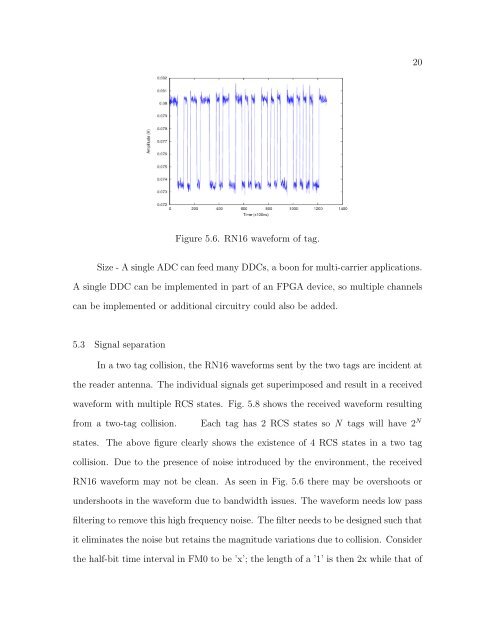utilizing physical layer information to improve rfid tag
utilizing physical layer information to improve rfid tag
utilizing physical layer information to improve rfid tag
Create successful ePaper yourself
Turn your PDF publications into a flip-book with our unique Google optimized e-Paper software.
Figure 5.6. RN16 waveform of <strong>tag</strong>.<br />
Size - A single ADC can feed many DDCs, a boon for multi-carrier applications.<br />
A single DDC can be implemented in part of an FPGA device, so multiple channels<br />
can be implemented or additional circuitry could also be added.<br />
5.3 Signal separation<br />
In a two <strong>tag</strong> collision, the RN16 waveforms sent by the two <strong>tag</strong>s are incident at<br />
the reader antenna. The individual signals get superimposed and result in a received<br />
waveform with multiple RCS states. Fig. 5.8 shows the received waveform resulting<br />
from a two-<strong>tag</strong> collision. Each <strong>tag</strong> has 2 RCS states so N <strong>tag</strong>s will have 2 N<br />
states. The above figure clearly shows the existence of 4 RCS states in a two <strong>tag</strong><br />
collision. Due <strong>to</strong> the presence of noise introduced by the environment, the received<br />
RN16 waveform may not be clean. As seen in Fig. 5.6 there may be overshoots or<br />
undershoots in the waveform due <strong>to</strong> bandwidth issues. The waveform needs low pass<br />
filtering <strong>to</strong> remove this high frequency noise. The filter needs <strong>to</strong> be designed such that<br />
it eliminates the noise but retains the magnitude variations due <strong>to</strong> collision. Consider<br />
the half-bit time interval in FM0 <strong>to</strong> be ’x’; the length of a ’1’ is then 2x while that of<br />
20
















